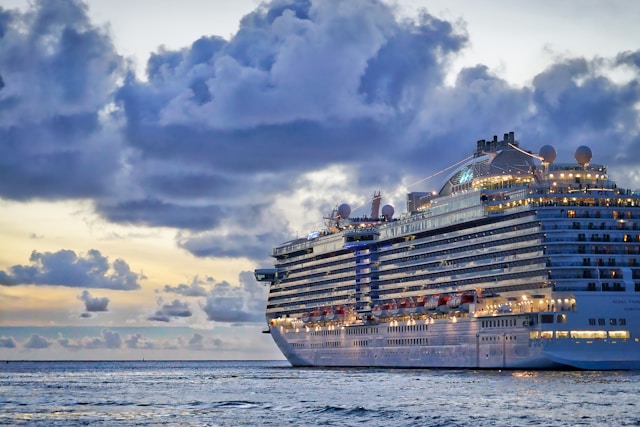If you’re traveling internationally with a layover in the United States on your way to another country, the C1 visa might be your ticket to seamless transit. Designed for brief stopovers, the C1 visa allows eligible travelers to pass through the US borders lawfully and efficiently.
This Remitly 2025 C1 transit visa guide breaks down what the C1 visa is, when it’s needed, who qualifies, and how to apply, so your transit is smooth and stress-free.
What is a C1 visa?
The C1 visa, or Transit Visa, is a non-immigrant visa issued to foreign nationals who are passing through the US on their way to another country. It allows for short stays, typically 29 days or less, at US airports or ports.
This visa does not allow the visa holder to enter the US for tourism, business, employment, or extended stays. It facilitates short-term passage through the US without granting broader access or privileges within the country.
When do you need a C1 visa?
Common situations that require this visa include:
- International flight layovers: if your flight itinerary includes a layover in the US before you board a connecting flight to a third country
- Airport changes: if you need to transfer between different US airports or terminals and will pass through US customs and immigration
- Cruise ship transfers: if you are boarding an international cruise departing from a US port, even if your final destination is outside the US.
Some travelers may not need a C1 visa if they already have a valid visa that permits brief entry into the US (such as a tourist visa or a B-1/B-2 visitor visa), or if they are eligible under the Visa Waiver Program (VWP) and meet the Electronic System for Travel Authorization (ESTA) requirements. If you are from a country that is not part of the VWP, you will likely need a transit visa, even if your stay is only a few hours.
What are the C1 visa restrictions?
The C1 visa comes with several strict limitations:
- No extended stay: You may not stay in the US beyond the immediate transit period, which typically must not exceed 29 days
- No tourism or personal visits: Sightseeing, visiting family or friends, or attending events is not allowed
- No work or study: You cannot work, intern, volunteer, or attend school while in the US
- Proof of onward travel: You are required to show a confirmed ticket for departure to your final destination, as well as a valid visa (if needed) for that destination
- Single-entry only: This visa is typically a single-entry visa, meaning you must leave the US after your transit and cannot re-enter without reapplying
Travelers who attempt to overstay their transit period or violate these restrictions may face visa removal, fines, or future travel bans to the US.
Eligibility requirements for a C1 visa
To be eligible for a C1 transit visa, you need to meet all of the following four conditions:
- You must be from a non-VWP country. Nationals of VWP countries may be able to transit the US using an approved ESTA instead. If you’re not eligible, you’ll need a C1 visa.
- You must be traveling to a third country. The US cannot be your final destination. Your travel itinerary must show confirmed plans to leave the US, such as a flight or cruise ticket to your next destination.
- You plan to stay in the US briefly and solely for transit. During your visa interview, you need to prove that you’re not attempting to enter the US for other purposes.
- You have strong ties to your home country. This could include a job, family ties, a property, or ongoing studies—anything that supports your intent to return home.
Other important considerations
In addition to the main eligibility criteria above, there are a few additional considerations to keep in mind. First, your travel must be uninterrupted and for immediate transit only. Be sure that you have valid documents for your final destination. You may be asked to show a valid visa or entry permit for that country (if applicable), along with any other required documentation.
If you’re part of an airline or maritime crew, such as pilots, flight attendants, or ship crew members, you will need to apply for a C1/D combination visa instead. This covers both transit and crew-related responsibilities. The C1 alone will not suffice.
Finally, keep in mind that each person traveling, including minors, must hold a separate C1 visa. Children must apply for their own visas and attend an interview unless they qualify for an age-based waiver (typically 13 and younger).
How to apply for a C1 visa
Step 1: Complete the DS-160 Form
Complete the Online Nonimmigrant Visa Application form (DS-160). It takes about 90 minutes to complete and includes uploading a compliant visa photo. Make sure to save the confirmation barcode for your visa interview.
Step 2: Pay the application fee
As of 2025, the fee is $185 USD. Pay through the US embassy or consulate website in your country. You may also be charged an issuance fee, depending on your nationality.
Step 3: Schedule a visa interview
Book an appointment with the nearest US embassy or consulate. Use the US Department of State’s wait time tool to plan. If you are under 13 or over 80, you will likely be exempt from an interview, but the consulate may still request one.
Step 4: Prepare for the interview
Gather all required documentation, including your passport, nonimmigrant visa application confirmation page, application fee payment receipt, and photo. Some embassies may request digital uploads of documents before your appointment.
Step 5: Attend the interview
During the interview, the consular officer will assess your intent and eligibility. Answer honestly and concisely. The officer may ask questions such as:
- Why are you traveling through the US?
- What is your final destination?
- Do you have family in the US?
The officer will also collect digital fingerprint scans during the interview.
Required documents for a C1 visa application
Make sure you have all of the following documents ready and organized before scheduling your visa appointment.
Core documentation checklist
Before scheduling your visa appointment, make sure you have all of the following documents:
- Passport: Ensure your passport is valid for at least six months beyond your planned entry date.
- DS-160 confirmation page: After completing the DS-160 form, you’ll receive a confirmation page with a barcode.
- Application fee payment receipt: The fee in 2025 is $185 USD. Once you complete payment, make sure to retain and print your receipt to show proof of payment.
- Travel itinerary: Include flight tickets or booking confirmations of other travel, such as cruises or trains.
- Proof of final destination: Include a valid visa or entry permit (if required) to your next country, an official letter of invitation or event registration, or hotel bookings or tour reservations.
- Proof of financial means: Include recent bank statements, a letter from your employer, or a notarized letter of financial support if someone else is funding your travel.
- Photograph: Submit a 2×2-inch photo that meets US visa photo requirements.
2025 updates you should know
In early 2025, the US Department of State introduced a few procedural changes:
- Digital document uploads: Physical copies are still required, but many embassies and consulates now also request digital uploads in advance.
- Health documentation: Depending on your departure country, you may need proof of vaccination.
- New DS-160 format: Ensure you’re using the most recent version of the application form.
Common mistakes to avoid
While the C1 visa seems straightforward, several mistakes could lead to visa denials or delays.
| Issue | Quick Fix |
| Misunderstanding the purpose of the C1 visa | Use C1 only for airport transit, and bring proof if switching airports or staying overnight. |
| Old or incomplete DS-160 leads to delays or rejection | Fill out the latest DS-160 online and double-check every field. |
| Unclear or inconsistent travel plans raise doubts about your intent | Bring a complete travel itinerary and proof of your final destination. |
| No financial proof suggests a risk of overstaying | Bring three months of bank statements or a sponsor letter. |
| Missing destination visa | Get your final destination visa first, or explain how/when you’ll get it. |
| Low-quality or incorrect photo | Use a professional visa photo service or follow US photo rules exactly. |
| No digital copies | Bring a USB or cloud folder with all your files to avoid delays. |
| One visa for the entire family | Submit a separate application for each traveler, even children. |
Application processing times
Processing a C1 visa involves both the interview wait time and the application review period. Interview wait times vary significantly by location and range anywhere from one to four weeks. After the interview, applications are typically processed within three to ten business days.
You should plan to begin the process at least four to six weeks in advance to avoid last-minute complications.
Final thoughts
The C1 visa is a crucial travel document for those passing through the US in 2025. Understanding the rules, preparing your documents, and applying with clear intent will help you avoid delays and get to your final destination without hassle. In addition to the C1 visa, applicants may also want to consider the h1b visa application process 2025, which requires careful attention to detail and adherence to the latest guidelines. Ensuring that all required documentation is in order will streamline your travel experience and minimize potential setbacks. Being proactive about your travel plans and visa applications can make all the difference in ensuring a smooth journey. Make sure to familiarize yourself with the q1 visa application process 2025, as it can vary from previous years. Staying informed about any changes or additional requirements will further streamline your journey. Remember, thorough preparation is key to ensuring a smooth transit experience through the US. Additionally, if you plan to extend your stay or transition to a different type of visa, be sure to research the dvisa longterm application process. Being aware of potential timelines and documentation needed for long-term visas can save you time and prevent complications. This proactive approach will enable you to navigate the complexities of US immigration with greater ease.
FAQs
Can I leave the airport with a C1 visa?
No, the C1 visa is intended for direct and continuous transit. You may be required to stay within the airport or pre-designated transit area.
What happens if my flight is delayed or canceled?
You are expected to leave the US as soon as possible. Keep documentation of your updated flight. Extended delays may require rescheduling or legal re-entry procedures.
Do I need a C1 visa if I’m switching terminals?
Yes, if you are passing through US immigration/customs or switching airports, you’ll likely need a C1 visa unless covered by the Visa Waiver Program (VWP).
Can I apply for a different visa after entering the US on a C1 visa?
No, the C1 visa is strictly for transit and does not allow adjustment of status within the US.
Is the C1 visa suitable for cruise ship passengers?
Only if the cruise requires a stopover in a US port on the way to another country. Maritime crew should apply for a C1/D visa instead.

